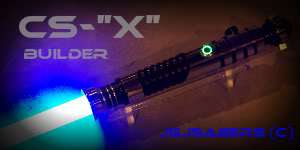just a few thoughts about how MR boards work. Not to teach a class about electronic and acoustics, but I've studied them a lill bit closer when designing buttered toast V2, to get a rough idea of their features and specs.
Here is what I know :
- audio amp : pretty ugly electronic solution. Single bipolar NPN transistor, emitter to the ground, speaker between positive of supply and collector of the transistor. Got a board with no sound ? guess what : probably the speaker is dead and in the worst case went in short circuit or so and burnt the output transistor. This transistor is easy to find on the board, you have 6 identical ones one behind the led strip connector. The audio amp transistor is just like those ones, 3 pins in triangle, impossible to miss the orientation / polarity. Somewhere in the middle of the board, close to the speaker wires.
If like me you use an external luxeon driver (like mine or corbin's one), you don't need anymore the one used to switch the LED strip. Savage one from the 6, and replace the audio amp transitor. Generally the have enough pin length so that you can cut the terminal, unsolder the rest of the wire, clean the solder pad and solder back the replacement transistor.
If you are using the board to power the luxeon, buy a BC547 NPN transistor at your local electronic shop. Inexpensive. Less than 1$ to repair a 45$ board, it's worth the effort.
Using a single transistor to make an audio amp is awfull cause you cannot have a symetric driving of the audio wave (you need 2 transistors to do so, it's called a pushpull) and moreover some current is flowing into the speaker even during zero crossing. However, to avoid depleting the batteries when off, the signal driving the output transistor is set to 0.
Although the solution is ugly (but damn cheap), sound is correct, sound contents has been tuned to match the audio amp solution.
- spectrum and digital resolution
quantification of the signal was easy to find out with an oscilloscope (the "gap" or "steps" between 2 consecutive samples) : the output Digital to Analog Converter (DAC) does not have a single reconstruction filter, not even a resistor/capacitor 1st order low pass filter, so the signal is "stepped". Don't hear the difference on the speaker ? so you don't need a filter ! (okay, I'm not blaming them, a cents is a cents, and it's true that you don't hear the difference on a 29 mm speaker, I therefore removed my filter on my V2).
I measured, if my memory is correct, a 14 or 16 kHz sample rate (7-8 kHz sound contents max), and I bet on 10 or 12 bit resolution. 10 bits are required to almost not hearing quantification noise (a little constant sssshhhhhhhhh noise in the sound background). You can hear it on my board (V1, 8 bit sounds). You can barely hear it with 10 bits, and it's better and better when you increase the resolution of the sounds (my V2 is 16 bits).
I patched a little program yesterday to make a spectral analysis of the board, using a little electret mike. I'll post the pictures later. Idle hum of the luke ep VI is around 650 Hz, clearly not the original 50 or 100 Hz of the original movie sounds. Easy to understand, such a little speaker starts at 400 or 500 Hz. Bass requires a big physical displacement of the membrane. Spectrum can be seen to extend up to 8 kHz during the clash.
I'm not at home right now, no FTP access, so I can't post the pics, I'll have to wait until I return from my trip.
Any thoughts, feedback or contribution in this field would be welcomed to increase (our posts count ?) the general knowledge base about MR boards.
Erv'





 Reply With Quote
Reply With Quote













Bookmarks